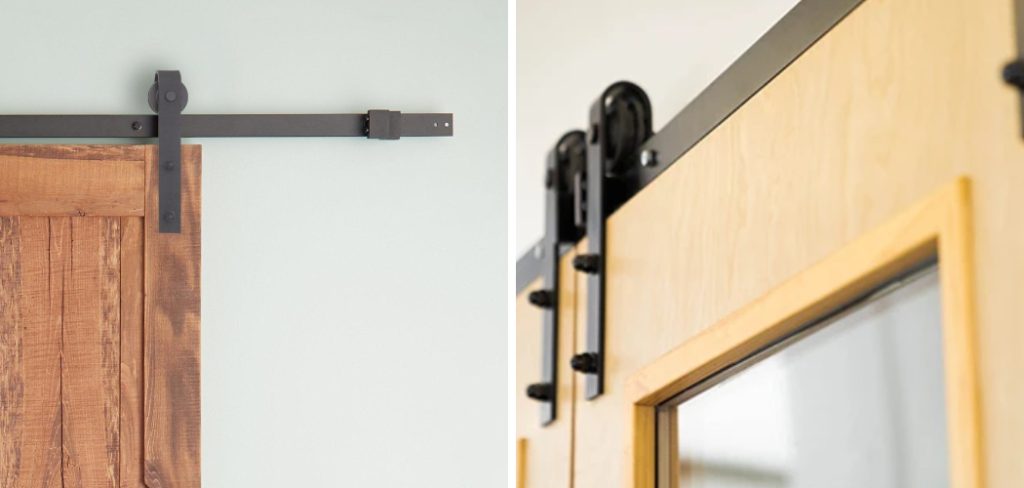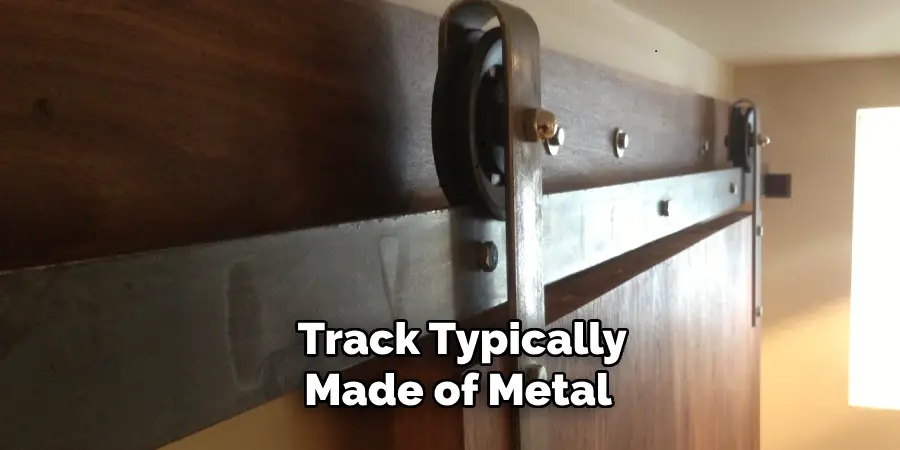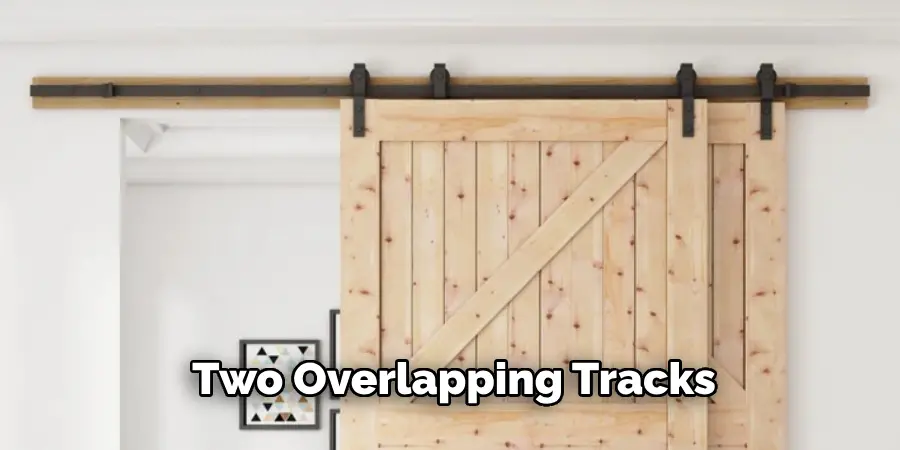Measuring for barn door hardware is a crucial step in ensuring a smooth and successful installation process. Barn doors have gained popularity for their rustic charm and space-saving functionality, but achieving the perfect fit requires precise measurements.

Whether you’re retrofitting an existing opening or planning a new installation, accurate measurements are essential for selecting the right hardware components and ensuring the door operates smoothly. Key measurements include the width and height of the door opening, as well as the thickness of the door itself.
Additionally, factors such as clearance space and track length should be considered to accommodate the door’s movement and provide adequate support. This article provides comprehensive guidance on how to measure for barn door hardware, offering tips, techniques, and considerations to help homeowners achieve a seamless and stylish barn door installation tailored to their specific space and needs.
The Rising Popularity of Barn Doors
Barn doors have surged in popularity in recent years, becoming a favored design element in both residential and commercial spaces.
This trend can be attributed to several factors, including their unique aesthetic appeal and functional advantages. Barn doors exude a rustic charm that can complement a variety of interior design styles, from modern farmhouse to industrial chic.
Their space-saving nature makes them an excellent choice for areas where traditional swinging doors might be impractical, such as small apartments or rooms with limited floor space.
Moreover, barn doors are available in a wide range of materials, finishes, and styles, allowing for customization to suit any décor. As a result, more and more homeowners and designers are opting for barn doors to add character and functionality to their spaces.
Importance of Proper Measurement for Barn Door Hardware
Proper measurement is the cornerstone of a successful barn door installation. Inaccurate measurements can lead to a host of issues, including misalignment, improper functioning, and even potential damage to the door or surrounding structures.
Ensuring that the door fits perfectly within the allotted space is critical to achieving a seamless operation and aesthetic appeal.

Accurate measurements will help you select the correct track length, determine the necessary clearance between the door and the wall or ceiling, and ensure that the door will slide effortlessly without obstruction.
This precision not only enhances the appearance and functionality of the barn door but also extends its longevity by reducing wear and tear caused by misalignment and improper installation.
Therefore, taking the time to measure meticulously is an investment in the durability and performance of your barn door setup.
Understanding Barn Door Hardware Components
Having a comprehensive understanding of barn door hardware components is essential for a successful installation. Each component plays a crucial role in the overall operation and stability of the barn door. The primary hardware includes the track, rollers, and mounting hardware.

The track, typically made of metal, serves as the guide along which the door slides. Rollers, often attached to the top of the door, allow it to move smoothly along the track. Additionally, the mounting hardware, which includes brackets, spacers, and fasteners, secures the track and ensures it is properly aligned and supported.
Other important components may include door guides, which keep the door stable and prevent it from swinging, and stoppers, which limit the door’s range of motion to prevent it from sliding off the track.
Understanding these components and how they work together will help you choose the right hardware kit and ensure a seamless and efficient barn door installation.
Different Types of Barn Door Hardware Systems
When selecting barn door hardware, it’s essential to understand the various types of systems available, each designed to meet specific functional and aesthetic requirements. Here are some of the most common types:
Single Track Systems
Single track systems are the most straightforward and commonly used barn door hardware setup. These systems feature one continuous track on which one or more doors slide. Single track systems are ideal for spaces where simplicity and ease of installation are a priority. They are versatile and can be used for single doors or pairs of doors that slide apart.
Bypass Systems

Bypass systems are designed for situations where space is limited and multiple doors need to be installed. This system features two overlapping tracks that allow doors to slide past each other. Bypass systems are perfect for closets, pantries, or areas where traditional hinged doors would consume too much space.
Bi-Parting Systems
Bi-parting systems involve two doors that slide away from a central point to opposite ends of the track. This setup is commonly used for grand entrances or large openings where a dramatic effect is desired. Bi-parting systems are available in single or double track configurations, depending on the required door movement.
Wall Mount Systems
Wall mount systems are designed for installations where the track is mounted directly onto the wall above the door opening. This system is ideal for spaces where ceiling mounting is not possible, such as rooms with low or angled ceilings. Wall mount systems provide a clean and minimalist look.
Ceiling Mount Systems

Ceiling mount systems are used when it is preferable or necessary to attach the track to the ceiling rather than the wall. This setup allows for greater flexibility in door height and is suitable for spaces with high ceilings or when the wall space is occupied by other décor or furnishings.
Soft-Close Systems
Soft-close systems incorporate mechanisms that gently bring the door to a close, preventing it from slamming shut.
This feature enhances the user experience by providing smooth and quiet operation, and can be added to both single and double track systems. Soft-close systems are particularly beneficial in reducing wear and tear on the hardware and door over time.
Implications of Proper Measurement for Hardware Compatibility
Accurate measurements are paramount when it comes to ensuring hardware compatibility in barn door installations.
Proper measurement affects not only the fit and function of the door but also the compatibility of various hardware components. Incorrect measurements can lead to purchasing incompatible tracks, rollers, and mounting hardware, which can delay your project and increase costs.
For example, if the track length does not match the door’s width plus an adequate overlap, the door may not cover the opening completely, defeating its functional purpose.

Similarly, mismatched roller sizes or mounting brackets can result in improper door alignment, causing friction and inhibiting smooth operation.
Furthermore, precise measurements help in choosing appropriately sized stoppers, guides, and spacers that ensure the door remains stable and secure during use. This precision also minimizes the risk of structural damage to the wall or ceiling due to incorrect load distribution.
In addition, some specialized systems like soft-close mechanisms require exact measurements for proper installation and optimal performance. In summary, meticulous measurement ensures that all hardware components are compatible, contributing to a seamless, efficient, and durable barn door installation.
10 Methods How to Measure for Barn Door Hardware
1. Determine Door Size and Weight
Before you can measure for barn door hardware, it’s essential to know the exact size and weight of the door you plan to install. Start by measuring the height and width of the door. For height, measure from the bottom of the door to the top edge. For width, measure across the door from one side to the other.
Additionally, it’s crucial to weigh the door, as barn door hardware comes with weight limits. Use a scale capable of handling the door’s weight, ensuring you have a reliable measurement. Knowing these dimensions and weight will help you select appropriate hardware that can support the door effectively.
2. Measure Doorway Opening
The next step is to measure the doorway opening where you intend to install the barn door. Measure the width of the doorway at the top, middle, and bottom to ensure that the opening is consistent and there are no irregularities. Measure the height of the doorway from the floor to the top of the opening.

These measurements will determine if you need to make any adjustments to the door size or if you need to account for additional space in your hardware selection. Accurate measurements will ensure that the door covers the opening properly and slides smoothly.
3. Calculate Track Length
The track length is a critical aspect of barn door hardware measurement. Generally, the track should be at least twice the width of the door to allow it to open fully without obstruction. For instance, if your door is 36 inches wide, you will need a track that is at least 72 inches long.
This calculation ensures that the door can slide completely out of the doorway opening, providing maximum access to the space. When selecting a track, consider the total length of the wall available, making sure there is enough room to accommodate the full track length without hitting any obstacles.
4. Assess Wall Space
It’s important to assess the available wall space next to your doorway. Measure the horizontal distance on both sides of the door opening to determine if there is sufficient space for the door to slide open. Ensure there are no switches, outlets, or other obstructions in the path of the sliding door.
If you have limited wall space, you might need to consider alternative hardware solutions like bypass or bifold barn doors, which require less space. This step ensures that the barn door can move freely along its track without any impediments.
5. Measure Clearance Above the Doorway
Barn door hardware requires clearance above the doorway for proper installation. Measure from the top of the doorway to the ceiling or any molding to determine how much space is available. Most barn door hardware systems need at least 6 inches of clearance, but this can vary depending on the style and manufacturer.

Adequate clearance ensures that the track and mounting hardware can be installed correctly and that the door can hang at the appropriate height. If the clearance is insufficient, you may need to look for low-clearance hardware options or modify the door or doorway to fit.
6. Check for Studs in the Wall
For secure installation, the barn door track must be mounted to the wall studs. Use a stud finder to locate the studs in the wall where you plan to install the track. Mark the stud locations clearly with a pencil.
Measure the distance between the studs, as this will influence the placement of the track and mounting brackets. Standard studs are spaced 16 or 24 inches apart, but this can vary. Ensuring that the track is anchored to the studs provides the necessary support for the door’s weight and ensures stability and safety.
7. Measure Door Overlap
To ensure that the barn door adequately covers the doorway when closed, you need to measure the door overlap. The overlap is the amount of space the door extends beyond the edges of the doorway opening.
Typically, an overlap of 1 to 2 inches on each side is recommended to ensure complete coverage and privacy.
Measure the width of the door opening and add 2 to 4 inches to this measurement. This calculation will help you determine the ideal width for your door to ensure it covers the opening completely when closed.
8. Determine Handle Height
Deciding on the height at which to place the door handle is another important measurement. The handle should be positioned at a comfortable height for all users. Measure from the floor to the desired height, which is typically around 36 to 42 inches, depending on the average height of users.
Mark this height on the door to ensure precise placement. Proper handle height ensures ease of use and ergonomic comfort. Additionally, consider the placement of the handle in relation to the door’s design and the room’s layout to ensure it is both functional and aesthetically pleasing.
9. Measure for Floor Guide
Floor guides are essential components that keep the door from swinging or swaying as it slides. Measure the thickness of the bottom edge of the door to select an appropriate floor guide.
The guide should match the door’s thickness for a snug fit. Measure the distance from the bottom of the door to the floor to determine the correct height for the floor guide installation.
Ensuring precise measurements for the floor guide placement helps maintain the door’s stability and smooth operation, preventing damage to the floor and door over time.
10. Measure for Soft Close Mechanisms
If you plan to install a soft close mechanism, which gently brings the door to a stop, additional measurements are necessary. Measure the length and height of the door to determine where the soft close mechanism will be installed on the track. The mechanism needs to be positioned correctly to function properly.
Follow the manufacturer’s instructions to measure the exact placement on the track and the corresponding part on the door. Accurate installation of the soft close mechanism enhances the functionality and safety of the barn door, preventing it from slamming shut and reducing wear and tear on the hardware.
Things to Consider When Choosing Barn Door Hardware
When selecting barn door hardware, several factors must be taken into account to ensure both functionality and aesthetic appeal. Here are some key considerations:
1. Door Material and Weight
The material and weight of your barn door significantly impact the choice of hardware. Heavy doors made of solid wood will require sturdier, more robust hardware systems, while lighter doors can use simpler mechanisms. Always check the weight capacity ratings of the hardware to ensure they match the specifications of your door.
2. Style and Finish
Barn door hardware comes in various styles and finishes, from rustic to modern, and in finishes such as brushed nickel, black matte, or antique bronze. Choose a style and finish that complements your interior design and enhances the overall look of your space.
3. Space Constraints
Evaluate the space surrounding your door opening. If wall space is limited, traditional sliding mechanisms might not be suitable. In such cases, alternative solutions like bifold or bypass doors can be considered, which require less wall space to operate.
4. Soft Close and Other Mechanisms
Consider whether you want to add special features like a soft close mechanism, which prevents the door from slamming shut, enhancing safety and longevity. Some hardware systems also offer quiet operation features, which can be beneficial in homes with small children or in noise-sensitive areas.
5. Installation Complexity
Some barn door hardware systems are more complicated to install than others, requiring special tools or expertise. Assess the complexity of the installation process and decide whether you can manage it as a DIY project or if you’ll need professional help.
Conclusion
Measuring for barn door hardware requires meticulous attention to detail to ensure a successful installation. Each measurement, from the door size to the soft close mechanisms, plays a crucial role in the overall functionality and aesthetics of the barn door system.
Now that you know how to measure for barn door hardware. While it does take a few steps each time, hopefully now you understand the process and why it’s worth taking the extra step to make sure your floor is properly cared for. So don’t wait any longer, take action today!
